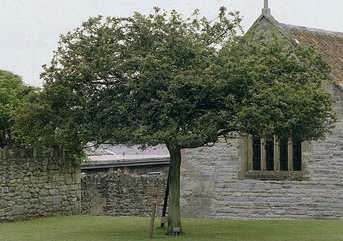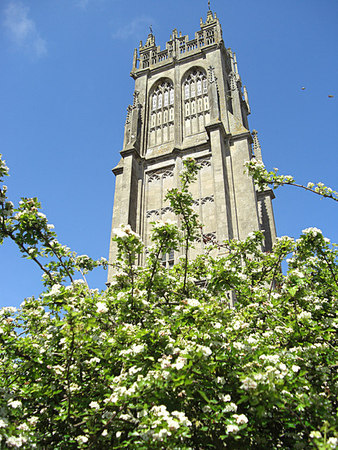The Glastonbury Thorn, Glastonbury, Somerset
By zteve t evans
|
|
The legend of the Glastonbury Thorn belongs to the group of legends that surrounds Joseph of Arimathea and his legendary part in bringing Christianity to Britain. As with all legendary people there are many versions of his different exploits and achievements that cannot be verified. Such is the stuff of legends and the following has been pieced together from different sources.
 Glastonbury Thorn at Glastonbury Abbey, 1984. This tree died in 1991 By Tom Ordelman
Glastonbury Thorn at Glastonbury Abbey, 1984. This tree died in 1991 By Tom Ordelman
Joseph and Jesus
Joseph was a man of rank in Jewish society, a wealthy merchant and reputed to be the great-uncle of Jesus. After the crucifixion of Jesus he became a Christian missionary who had been given the task by St Philip, along with others, of establishing Christianity in Britain. He arrived in Britain bringing with him a handful of followers, the Holy Chalice and his staff.
According to legend on arriving in England he traveled to Glastonbury which was, even then, a spiritual centre. In those days Glastonbury was virtually an island that could be reached by the sea. Arriving at Wearyall Hill he thrust his staff into the ground. The legend says that overnight it grew into a blossoming thorn tree.
The thorn tree is said to blossom on Christmas Day every year. A ritual involving local school children sees a sprig from the tree cut and sent to the monarch to decorate their breakfast table on Christmas Day. The sprig is taken from a thorn tree in the grounds of St John's Church which said to be a tree descended from the original tree that grew from Joseph's staff.
Although many people give Joseph credit for building the first Christian church in Britain and possibly the world, there is very little hard evidence to prove it. The presence of Joseph in Britain is shrouded in myth and legend and the first literary reference to him in Britain came in the 9th century. The Glastonbury Thorn was mentioned in medieval texts and in the Lyfe of Joseph of Arimathea, a 16th century anonymous work that reported that it was unusual in that it flowered twice a year. Once in spring and again around mid winter during mild weather and was thought of as being miraculous.
Joseph was a man of rank in Jewish society, a wealthy merchant and reputed to be the great-uncle of Jesus. After the crucifixion of Jesus he became a Christian missionary who had been given the task by St Philip, along with others, of establishing Christianity in Britain. He arrived in Britain bringing with him a handful of followers, the Holy Chalice and his staff.
According to legend on arriving in England he traveled to Glastonbury which was, even then, a spiritual centre. In those days Glastonbury was virtually an island that could be reached by the sea. Arriving at Wearyall Hill he thrust his staff into the ground. The legend says that overnight it grew into a blossoming thorn tree.
The thorn tree is said to blossom on Christmas Day every year. A ritual involving local school children sees a sprig from the tree cut and sent to the monarch to decorate their breakfast table on Christmas Day. The sprig is taken from a thorn tree in the grounds of St John's Church which said to be a tree descended from the original tree that grew from Joseph's staff.
Although many people give Joseph credit for building the first Christian church in Britain and possibly the world, there is very little hard evidence to prove it. The presence of Joseph in Britain is shrouded in myth and legend and the first literary reference to him in Britain came in the 9th century. The Glastonbury Thorn was mentioned in medieval texts and in the Lyfe of Joseph of Arimathea, a 16th century anonymous work that reported that it was unusual in that it flowered twice a year. Once in spring and again around mid winter during mild weather and was thought of as being miraculous.
 A Holy Thorn in blossom - By michael ely
A Holy Thorn in blossom - By michael ely
The variety of hawthorn
The Glastonbury Holy Thorn is a variety of hawthorn known as Crataegus monogyna 'Biflora' a species that flowers twice a year in spring and winter. The trees found in the Glastonbury area have been propagated since ancient times. In favourable weather conditions it can flower at Easter and Christmas.
The original tree was destroyed during the English Civil War (1642-52) as a relic of heresy, by supporters of Oliver Cromwell. However, the legend tells that parts of the tree were saved and propagated in secret. Since then it has been propagated a number of times and more than one of its descendants is still believed to be alive. There is one tree in in the churchyard of the Church of St John grown from a cutting of the original and another in Glastonbury Abbey. One tree on Wearyall Hill that was planted and vandalized and further replacement trees were also subject to hooliganism but the line continues. There are other trees of the lineage in locations around Glastonbury and in other parts of Britain and some have been sent abroad.
The legacy of the Glastonbury Thorn
The Holy Thorn is very much revered by many people for many reasons. Some see it as an ancient symbol of Christian beliefs and a tangible presence from the distant past carrying a message for the present and the future.
© 18/01/2015 zteve t evans
The Glastonbury Holy Thorn is a variety of hawthorn known as Crataegus monogyna 'Biflora' a species that flowers twice a year in spring and winter. The trees found in the Glastonbury area have been propagated since ancient times. In favourable weather conditions it can flower at Easter and Christmas.
The original tree was destroyed during the English Civil War (1642-52) as a relic of heresy, by supporters of Oliver Cromwell. However, the legend tells that parts of the tree were saved and propagated in secret. Since then it has been propagated a number of times and more than one of its descendants is still believed to be alive. There is one tree in in the churchyard of the Church of St John grown from a cutting of the original and another in Glastonbury Abbey. One tree on Wearyall Hill that was planted and vandalized and further replacement trees were also subject to hooliganism but the line continues. There are other trees of the lineage in locations around Glastonbury and in other parts of Britain and some have been sent abroad.
The legacy of the Glastonbury Thorn
The Holy Thorn is very much revered by many people for many reasons. Some see it as an ancient symbol of Christian beliefs and a tangible presence from the distant past carrying a message for the present and the future.
© 18/01/2015 zteve t evans
References and Attributions
Copyright January 18th, 2015 zteve t evans
Copyright January 18th, 2015 zteve t evans
